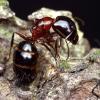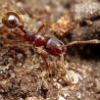Start: 2/14/2018
While my friend Derpy was visiting SoCal, he bought me a Novomesssor colony, as well as a Camponotus Laevgatus for himself, both from nurbs. When I got them, around new years, they were at 14 workers. They were having issues in the formicarium they were in because whenever I opened the lid, they would just run out, since they were a slightly larger colony, which is why I made and moved them into a firebrick formicarium. I also realized that lots of times after a worker escaped, and I picked it up on a cotton swab or a q-tip, it would sit in the outworld for a few days and die. I lost around 4 workers because of this, but they gained back up to 15 workers. They currently have 2-3 pre pupa larvae and around 10 smaller ones, that should pupate within the next 2 or so weeks. I am currently heating them with a heating cable applied to the side of their formicarium, but I just ordered a heating lamp setup (60 watt ceramic bulb) to heat all of my colonies at once, and I will use it to heat them instead of the heating cable (11.5 ft zoo-med) when it arrives in the mail. The queen lays eggs in batches, usually pausing for just under a week before shooting out around 5-15 more. I feed them a small cricket every 2 days, and small apple slices twice a week. At first, I had fed them only twice a week, but I experimented with feeding them more, and the larvae consumed it all within a day, so I decided to stick to that feeding regimen.
Edit: I also feed them crushed sunflower seeds and a birdseed mix, but I have yet to see them eating either. I will try to feed them this again today.
If anyone has some tips on keeping these, please do let me know ![]() !
!
Now here are some pictures (I will get better ones next time, these were very rushed ![]() )
)
Up close of a worker
Nest
Outworld
Edited by YsTheAnt, June 6 2018 - 3:31 PM.























